by Ron Ploof | Oct 25, 2020 | Metaphor
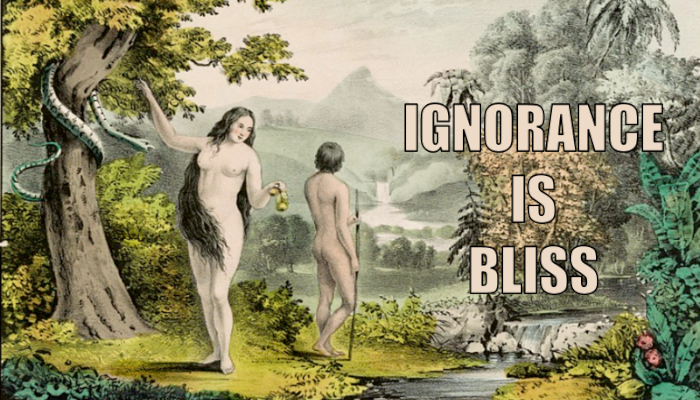
The sixth post in a series on metaphor
Life is a crazy, mixed-up ball of contradictions that we’re forced understand as we navigate through it. Luckily, we have metaphor as a tool to explain the human condition’s incongruities. For example, let’s take a look at the metaphor Ignorance is bliss.
Merriam-Webster has this to say about each word:
- Ignorance: “a lack of knowledge, understanding, or education.” Synonyms include: cluelessness, innocence, and obliviousness
- Bliss: “complete happiness” with synonyms such as heaven and paradise.
At first glance, it looks like they have nothing in common. But when you add the human experience, we begin to see a close relationship that we’ve told stories about for centuries. The Old Testament described how a bite of fruit from the tree of knowledge altered Adam and Eve’s Garden of Eden bliss into one of danger and shame. Siddhartha Gautama meditated under a Bodhi tree (tree of enlightenment) and emerged as the Buddha: the enlightened one, who awoke from a perpetual sleep-walk through life. Both stories are built upon the metaphor: ignorance is bliss.
The first post of this series described how metaphors transfer properties from the word to the right of “is” (bliss) to the word on the left (ignorance). In doing so, the metaphor attempts to connect happiness with a lack of knowledge. Before eating the forbidden fruit, Adam and Eve experienced a false sense of security. But, just because one feels safe, one isn’t protected from danger.
So why eat from the tree of knowledge? Why meditate under the tree of enlightenment? The answer is found in the antonym to ignorance: knowledge.
If ignorance is bliss, then knowledge is power.
In other words, ignorance is weakness in a world where survival requires strength.
Photo Credit: N. Currier. Adam and Eve in the Garden of Eden. , 1848. [New York: N. Currier] Photograph. https://www.loc.gov/item/90708415/.
by Ron Ploof | Sep 27, 2020 | Metaphor
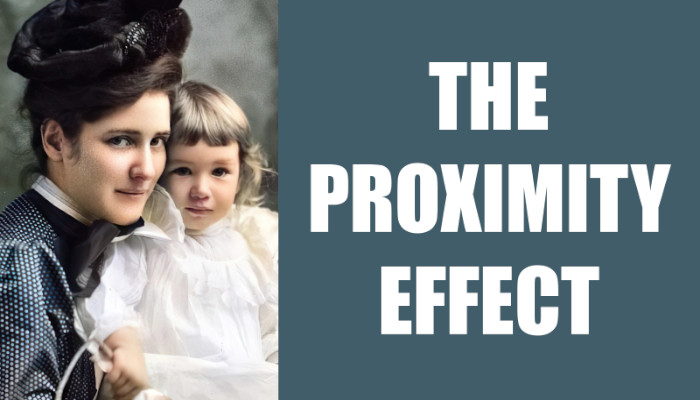
The fifth post in a series on metaphor
Sound engineers know that the closer something is to a microphone, the fuller its sound. Known in the music industry as the Proximity Effect, the phenomenon results in microphones capturing more of a close source’s low frequency tones (think James Earl Jones) than it’s higher frequency cousins (think Mickey Mouse).
We’ve all experienced the Proximity Effect. As babies, we learned to associate close sounds with intimate moments. Consider a mother holding her baby while singing a soft lullaby. From the baby’s perspective, not only is her voice warmed by the Proximity Effect, but it’s doubly-enhanced with the even bassier vibrations from within her chest.
Now consider Mom leaning close and whispering into the baby’s ear. Think about how distance affects a whisper. A soft whisper next to one’s ear sounds rich and full, while that same whisper a few feet away sounds thin and glassy. Or, from the Mom’s perspective, imagine the difference between her baby cooing right next to her ear and hearing that same coo from across the room. The first is intimate. The second is cute.
Yet, that’s only the positive side of lower frequencies. Close Mom whispers and baby coos are perceived as positive because they are wanted. When those low frequencies aren’t wanted, however, they can signal danger. Consider the two unsettling notes that define the movie Jaws. Dah-Dum. Dah-Dum.
The effect that proximity has on our perceptions is best summed up by the metaphor: Proximity is Power. The closer an entity is to us, the more power it’s perceived to have. If a close object is wanted, the power has a positive effect. If it’s unwanted, however, proximity can be interpreted as a threat. As a result, an entity’s perceived power can be interpreted as either protective or dangerous.
Close entities have an unfair advantage over us because their relative importance is inversely proportional to distance. An object miles away is of little significance, yet that same object inches away demands our total attention–to the exclusion of anything else around us.
Because the concept of proximity and power is so universally understood, it’s an effective tool to use when trying to explain something’s relevance. The next time you need to convey a concept’s vitality, consider incorporating proximity into your explanation. Ask yourself, “How can I express this thought using the metaphor: Proximity is power? How can I use the multi-dimensional concept of closeness, whether it be physical, emotional, temporal, or relational to make my point?”
Photo Credit: C.M. Bell, photographer. Fraser, Mrs. & baby., 1894. [between February and February 1901] Photograph. https://www.loc.gov/item/2016697211/.
by Ron Ploof | Aug 9, 2020 | Business Storytelling, Metaphor
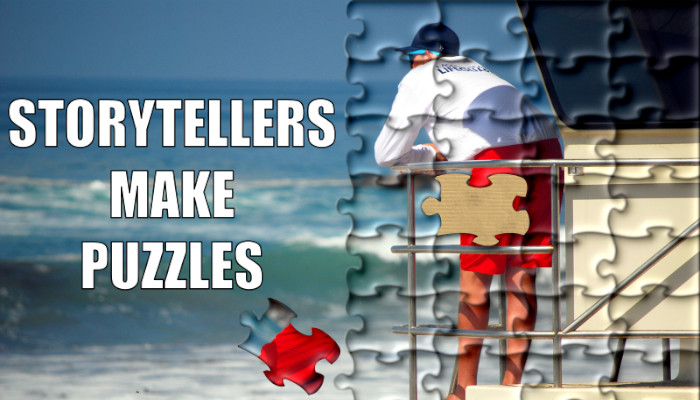
The third in a series on metaphor
Jessica and Rob, cast members of the reality television series Below Deck Mediterranean, are attracted to one another. As they get closer, we learn something that Jessica doesn’t know–that Rob is in an open relationship with his girlfriend back home. When another cast member decides to drop that bombshell into a group conversation, we see Jess’s physical expression change dramatically as she retreats into her thoughts.
Rob notices and asks, “What puzzle are you trying to put together?”
I grabbed the remote control, hit the pause button, and repeated the question out loud. “What puzzle are you trying to put together?” I loved this question because it reveals the storyteller’s role–to create puzzles for their audiences to solve.
Storytelling works because it mimics our never ending cycle of rectifying new knowledge with our prior knowledge. When we see, hear, feel, taste or touch something that defies our understanding, we become fixated and thus mentally paralyzed. Just as Jessica turned inward to rectify her feelings for Rob with this new information, dichotomies force our minds into overdrive–shutting out the rest of the world until we can square up the two competing thoughts.
Good storytellers create puzzles to hold people’s attention. Great storytellers balance the difficulty of solving those puzzles–too easy bores an audience, while too difficult makes them give up.
Which brings us to the focus of this series. If storytellers create puzzles that our brains are programmed to solve, then metaphors are super puzzle pieces that fill the gap between prior knowledge and new knowledge. While “Meghan is a rock” may at first blush seem like a puzzle, it resolves itself quickly as our brains transfer the properties of rocks to define her personality.
If stories are puzzles, metaphors are the super pieces.
by Ron Ploof | Jul 26, 2020 | Metaphor
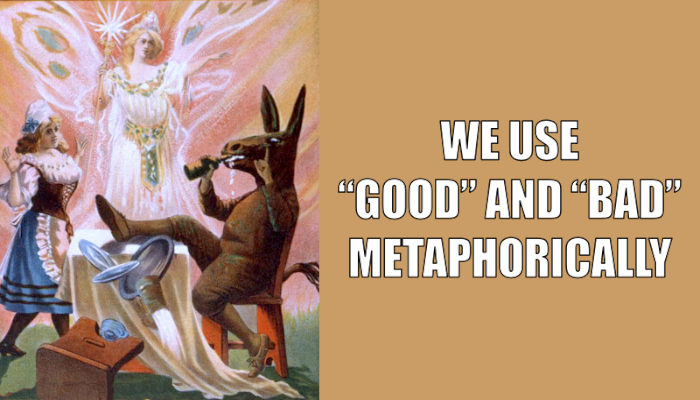
The second post in a series on metaphor
Last post, we described how humans use metaphor to transfer the properties of one thing to another. Today we discuss the value-judgments that we make with respect to those properties.
Metaphor works because we all share one thing: the human condition. George Lakoff and Mark Johnson explain how.
“We are physical beings, bounded and set off from the rest of the world by the surface of our skins, and experience the rest of the world as outside us. Each of us is a container, with a bounding surface and an in-out orientation onto other physical objects that are bounded by their surfaces. Thus, we also view them as containers with an inside and an outside.”1
Humans are autonomous beings who wonder through the world collecting experiences as we interact with physical phenomena. We learn that the sun comes up every morning and sets every night. We go to bed at night and wake up in the morning. When we get out of bed, gravity holds our feet to the ground and the friction between our feet and the floor allows us to propel forward rather than slipping and falling. We breathe in a mixture of nitrogen and oxygen and expel carbon dioxide. When we touch a hot stove we pull away quickly, yet when we experience the embrace of a warm hug, we pull closer.
We rely on our five senses to navigate through this world through our senses of sight, sound, taste, touch, smell. All rely on measuring differences–in light (sight); sound pressure (hearing), flavor (taste), hardness, texture, temperature, weight (touch), and fragrances (smell). Because our senses are built upon determining differences, we make value-judgments and categorize some as pleasant (good) and others as unpleasant (bad).
Sight: We need light to see, thus more light is perceived as better than less light. Since we prefer brightly lit objects to dimly lit ones, we categorize the former as good and the latter as bad. For example, take a look at the following metaphoric properties based on the sense of sight.
- Bright hope
- Dim despair
- Sharp argument
- Fuzzy logic
Sound: Our ears discern differences in sound pressures–the larger difference, the louder the sound. Since loud sounds startle while soft sounds soothe, we associate loud with bad and soft with good. But, there’s some additional subtlety here because not all soft sounds are pleasant. Certain musical notes played simultaneously clash, while others form beautiful harmonies. Consider the following metaphoric properties based on the sense of hearing.
- Soft-spoken words
- Loud-mouthed diatribe
- Harmonious voices
- Discordant views
Touch: Our sense of touch helps determine differences in texture, hardness, temperature, and weight. We associate those that bring pleasure as good (smooth, soft, warm, light), and those that don’t (jagged, solid, hot/cold, heavy) as bad.
- Rough patch
- Smooth sailing
- Hard edge
- Soft landing
- Warm hands
- Cold heart
- Heavy response
- Light touch
Taste: Our sense of taste helps us discern five different flavors: sweet, sour, bitter, salty, and savory. We consider some to be more pleasurable (good) than others (bad), like:
- Sweet melody
- Sour note
- Bitter defeat
- Salty language
- Savory victory
Smell: Our noses can discern trillions of different scents–some that we enjoy (good) and others that we don’t (bad), as in:
- Fishy concept
- Sniff test
- Love stinks (yeah, yeah)
We’re autonomous beings, wandering through the same physical environment with the help of our five senses. We associate properties with the things that we encounter and simultaneously attach the concept of good and bad to them. Finally, we convey new meaning to other autonomous beings by transferring these properties and value judgments through metaphor.
Notes:
Photo Credit: U.S. Lithograph Co, and Chas. H Yale. Chas. H. Yale’s everlasting Devil’s auction. , ca. 1904. Cincinnati ; New York: U.S. Lithograph Co. Photograph. https://www.loc.gov/item/2014635390/.
1. George Lakoff and Mark Johnson, Metaphors We Live By (University of Chicago Press, 2003) Kindle e-book location 521/4362
by Ron Ploof | Jul 12, 2020 | Metaphor
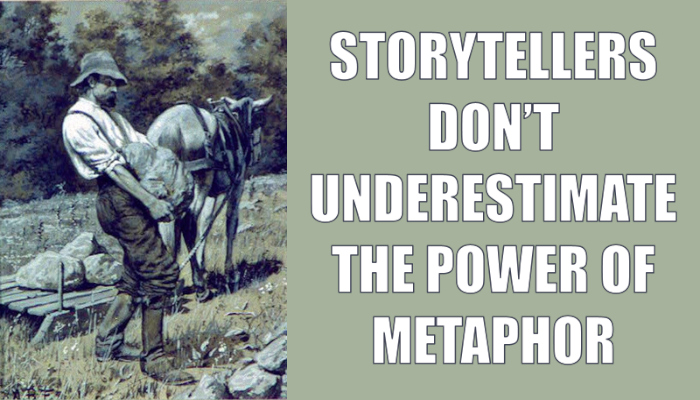
This is the first of a multi-part series on metaphor
Metaphor. It’s both misunderstood and underappreciated. And while most people have an elementary understanding of it–the act of describing one thing in terms of something else–they stop there, failing to recognize the role it plays in human thought, understanding, and communications. Therefore, it’s time to give metaphor the respect that it deserves.
Metaphor comes from the Greek words metaphora (a transfer) and metapherein (to transfer). So, rather than describing one thing in terms of another, metaphors transfer the properties of one thing to another.
We learn new properties everyday. For example, have you ever picked up a stone, stubbed your toe on one, or used one to hold a stack of paper napkins from flying away in the breeze? Each of these experiences helps us ascribe new properties to stones. Over the years we’ve learned that stones are heavy and hard. They retain heat, which makes them useful for stone-fired ovens. Big stones are difficult to move, but once they get rolling, they’re difficult to stop. Stones sink in water, but when thrown at precisely the right angle, they can skip multiple times across a pond. Humans have applied stone properties to hammer tent stakes, add ballast to ships, and construct stone buildings.
If metaphor is the root of all human understanding, then properties are the roots of all metaphors. Those who want to share a new idea, make a point, or teach a new concept must first figure out how to transfer the universally-known properties of one thing to something else.
For example, if you wanted to describe your friend’s emotional strength, you might say something like, “Meghan’s a rock.” Of course, you aren’t establishing an equivalence between Meghan and a rock, but rather, you’re transferring properties of rocks (strength and solidness) to represent her fortitude.
There’s also something special to note with respect to this idea of equivalence and transfer. Property transfers only go in one direction. For example:
We can interchange the following statements as equivalent: twelve is a dozen | A dozen is twelve, but, we can’t do the same with: Meghan is a rock | A rock is Meghan.
The former defines two things as equivalent. The latter transfers properties from an inanimate object to a person.
Metaphor is much more than a creative writing technique. It’s the bedrock of all human understanding. We’ll continue to dive deeper over a series of upcoming posts.
Photo Credit: Frost, A. B. , Artist. Man Unloading Stones from Sledge. , None. [Between 1870 and 1928] Photograph. https://www.loc.gov/item/2010715887/




